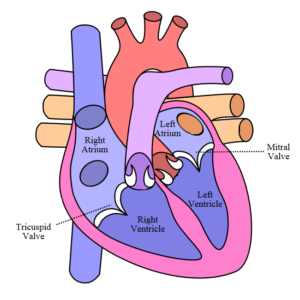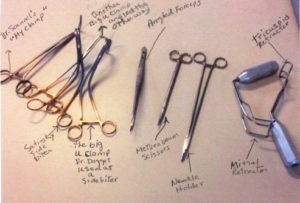By Tegan Kehoe
Often, the best way to solve a museum mystery is to go straight to the source. In March, the Paul S. Russell, MD Museum of Medical History and Innovation at Massachusetts General Hospital received a wonderful donation of items related to cardiac surgery through the years, as we prepared for an exhibit on the topic. The donation included a number of highly specialized surgical tools. It was clear that in each pair of scissors and forceps, the precise size, curve, and direction of the tip was important, but our team didn’t know what the tools were called or what they did. The usual print sources, such as medical textbooks and supply catalogs, didn’t clear up these differences. If these had been antique tools, we might have been stumped. Luckily, they were used within living memory. A senior surgeon at MGH was kind enough to help us out. As it turns out, some of the names were surprisingly silly.

Differently shaped valves call for differently shaped tools. Image adapted from Wikimedia Commons, original artist unknown.
One of the first puzzles was a pair of implements that look like tools a dentist might use to keep your cheek out of the way while working on a back molar. At first glance, the two tools look identical, or like a mirror image of one another, but almost every angle is different. It turns out that one is a mitral retractor, and the other is a tricuspid retractor. They are a lot like that tool at the dentist, in that they keep a piece of tissue spread back and out of the way during a procedure. Each one can be clamped into a metal frame that rests on a patient’s chest. The mitral retractor is used on the left side of the heart, and the tricuspid retractor on the right, each between the top and bottom chambers (left or right atrium and ventricle). So, these two tools would be mirror images of each other, except that the heart is not symmetrical.
It seems that the names for some of these tools are either too long, or too boring, for some surgeons, and each team develops their own language. Metzenbaum scissors, which are used to cut delicate tissue during organ operations, are nicknamed “bombers.” Chest scissors become “chesties,” and a pair of “funny looking scissors” was dubbed “funnies.” J. Gordon Scannell, MD, who performed Mass General’s first heart surgery in 1951 and first open heart surgery in 1955, was responsible for one of the nicknames. He had brought back a particular surgical clamp after a trip to England, and always referred to it as his clamp. Because the others in the OR heard him call it “my clamp” so often, they started calling it “the my clamp.”

Some notes on what’s what.
During an operation, all of the tools that the team will need are usually prepared and placed in the area considered the sterile field, so that no one has to leave the sterilized space during a procedure. One of the most fun tool nicknames was for a particular suction pump. Suction is used to clear excess fluid (usually blood) so a surgeon has a clear view of an operation. One time, a surgeon couldn’t remember the name and got testy when the scrub corrected him. He said, “I don’t care if it’s called the Empire State Building, when I am doing a mitral valve, I want it on the field.” Naturally, it has been known ever since as the Empire State Building among the people who were there and their colleagues.
If you’re in Boston, stop by the Russell Museum to see our exhibit on cardiac surgery. The tools described here aren’t on display – some of them were displayed in a pop-up exhibit we did for an event – but you can see an early heart-lung machine and more.
Tegan Kehoe is the exhibits and education specialist at the Russell Museum.
